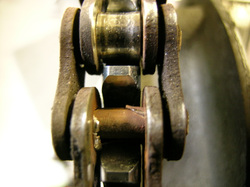Motorcycle and ATV chain inspection
Chain gang, does it need replaced?

Originally posted on ATV Magazine
March 25, 2010 by Jon Rhodig
As spring rolls around and the weather for most of us starts showing signs of becoming moderate, we start getting the itch to ride more frequently it is time to get that machine out of storage. Now if you have followed my previous tips on how to put your machine away for those winter months, you probably already have check your chain and put a good coating of some sort of rust preventative spray on it. But you may have not checked it closely for wear, or put off replacing it because “Its in winter storage, I will do that later”. Well later is here and no one wants to be stranded, DNF’ed or inconvenienced on the first ride or race out after the off season with a broken or sloppy chain.
Now obviously this only applies to those of us with chain final drive ATV (primarily sport ATVs and older Utes). There are only 2 basic types of chain – standard and o-ring (also x-ring but it is similar to o-ring).
Standard Chain
A good visual inspection will tell you a lot. If the chain’s rollers and side plates are extensively rusted as in there is absolutely no shiny metal showing, throw it out. If there is only slight surface rust you will need to remove it to check it out further. After removing the chain fold it over on itself in half. If you can lay the ends side by side the rollers and side plates are worn out and the chain is nearing it’s useful life. Also if there is missing rollers it is time for a new one. You can also measure a new chain and compare that to your old chain’s measurements and replace when the old chain stretches 2% over the new chain.
O-ring and X-ring Chain
Basically the same things apply to these types of chains, except since they contain little neoprene or rubber O-rings to seal in the lubricant for the roller bearings it requires a more scrutinizing. If the chain checks out on all the above criteria, but O-rings are missing, cracked, torn, or just generally worn to the point that the lubricant can be seen leaking past them, the chain should be replaced soon.
As with both types of chains it is almost mandatory to replace the sprockets along with the chain to maximize the life of all the components. Running a new chain on old sprockets drastically shortens the life of the new chain’s rollers. So with the new ridding season upon us don’t overlook one of the most overlooked parts on a chain driven machine – the chain.
March 25, 2010 by Jon Rhodig
As spring rolls around and the weather for most of us starts showing signs of becoming moderate, we start getting the itch to ride more frequently it is time to get that machine out of storage. Now if you have followed my previous tips on how to put your machine away for those winter months, you probably already have check your chain and put a good coating of some sort of rust preventative spray on it. But you may have not checked it closely for wear, or put off replacing it because “Its in winter storage, I will do that later”. Well later is here and no one wants to be stranded, DNF’ed or inconvenienced on the first ride or race out after the off season with a broken or sloppy chain.
Now obviously this only applies to those of us with chain final drive ATV (primarily sport ATVs and older Utes). There are only 2 basic types of chain – standard and o-ring (also x-ring but it is similar to o-ring).
Standard Chain
A good visual inspection will tell you a lot. If the chain’s rollers and side plates are extensively rusted as in there is absolutely no shiny metal showing, throw it out. If there is only slight surface rust you will need to remove it to check it out further. After removing the chain fold it over on itself in half. If you can lay the ends side by side the rollers and side plates are worn out and the chain is nearing it’s useful life. Also if there is missing rollers it is time for a new one. You can also measure a new chain and compare that to your old chain’s measurements and replace when the old chain stretches 2% over the new chain.
O-ring and X-ring Chain
Basically the same things apply to these types of chains, except since they contain little neoprene or rubber O-rings to seal in the lubricant for the roller bearings it requires a more scrutinizing. If the chain checks out on all the above criteria, but O-rings are missing, cracked, torn, or just generally worn to the point that the lubricant can be seen leaking past them, the chain should be replaced soon.
As with both types of chains it is almost mandatory to replace the sprockets along with the chain to maximize the life of all the components. Running a new chain on old sprockets drastically shortens the life of the new chain’s rollers. So with the new ridding season upon us don’t overlook one of the most overlooked parts on a chain driven machine – the chain.
